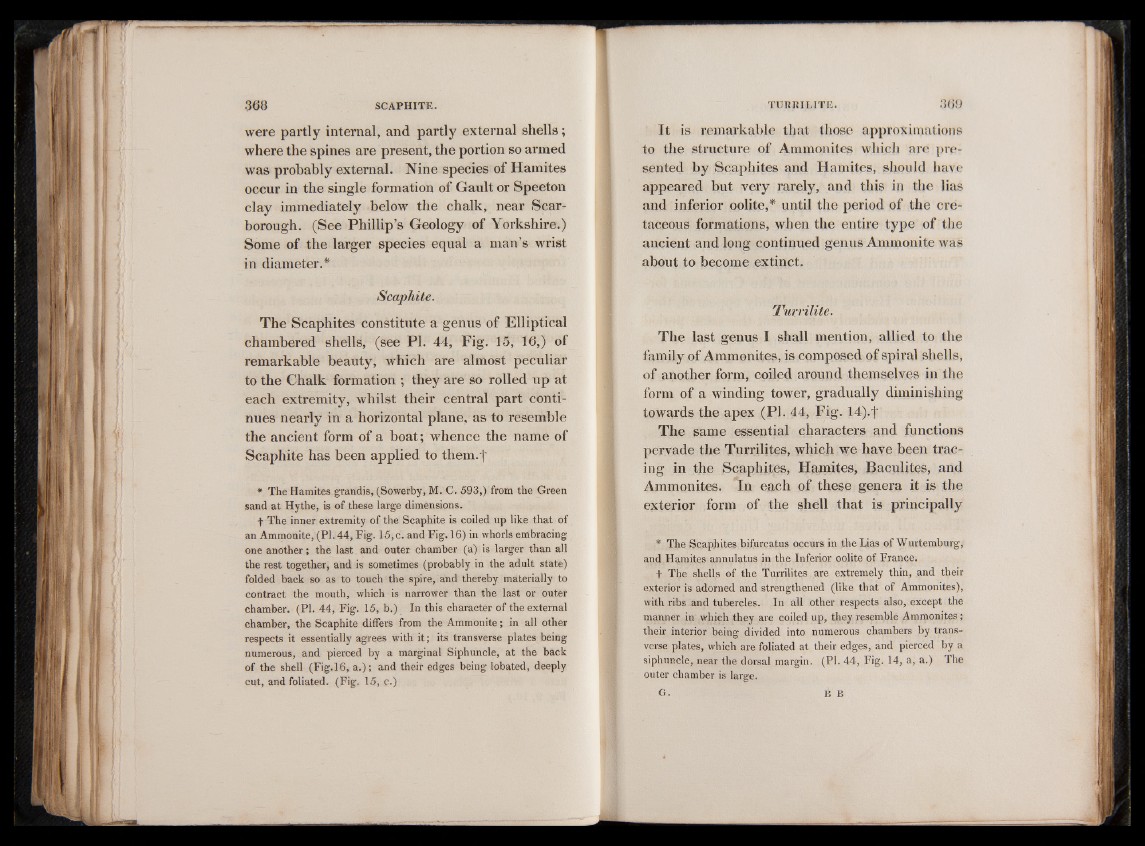
were partly internal, and partly external shells ;
where the spines are present, the portion so armed
was probably external. Nine species of Hamites
occur in the single formation of Gault or Speeton
clay immediately below the chalk, near Scarborough.
(See Phillip’s Geology of Yorkshire.)
Some of the larger species equal a man’s wrist
in diameter.*
Scaphite.
The Scaphites constitute a genus of Elliptical
chambered shells, (see PI. 44, Fig. 15, 16,) of
remarkable beauty, which are almost peculiar
to the Ghalk formation f they are so rolled up at
each extremity, whilst their central part continues
nearly in a horizontal plane, as to resemble
the ancient form of a boat ; whence the name of
Scaphite has been applied to them.f
* The Hamites grandis, (Sowerby, M. C. 593,) from the Green
sand at Hythe, is of these large dimensions.
f The inner extremity of the Scaphite is coiled up like that of
an Ammonite, (PI. 44, Fig. 15,c. and Fig. 16) in whorls embracing
one another; the last and outer chamber (a) is larger than all
the rest together, and is sometimes (probably in the adult state)
folded back so as to touch the spire, and thereby materially to
contract the mouth, which is narrower than the last or outer
chamber. (PI. 44, Fig. 15, b.) In this character of the external
chamber, the Scaphite differs from the Ammonite; in all other
respects it essentially agrees with it ; its transverse plates being
numerous, and pierced by a marginal Siphuncle, at the back
of the shell (Fig.16, a.); and their edges being lobated, deeply
cut, and foliated. (Fig. 15, c.)
It is remarkable that those approximations
to the structure of Ammonites which are presented
by Scaphites and Hamites, should have
appeared but very rarely, and this in the lias
and inferior oolite,* until the period of the cretaceous
formations, when the entire type of the
ancient and long continued genus Ammonite was
about to become extinct.
'Furjilite.
The last genus I shall mention, allied to the
family of Ammonites, is composed of spiral shells,
of another form, coiled around themselves in the
form of a winding tower, gradually diminishing
towards the apex (PI. 44, Fig. 14).f
The same essential characters and functions
pervade the Turrilites, which we have been tracing
in the Scaphites, Hgmites, Baculites, and
Ammonites. In each of these genera it is the
exterior form of the shell that is principally
* The Scaphites bifurcatus occurs in the Lias of Wurtemburg,
and Hamites annulatus in the Inferior oolite of France.
f The shells of the Turrilites are extremely thin, and their
exterior is adorned and strengthened (like that of Ammonites),
with ribs and tubercles. In all other respects also, except the
manner in which they are coiled up, they resemble Ammonites;
their interior being divided into numerous chambers by transverse
plates, which are foliated at their edges, and pierced by a
siphuncle, near the dorsal margin. (PI. 44, Fig. 14, a, a.) The
outer chamber is large.
G. B B